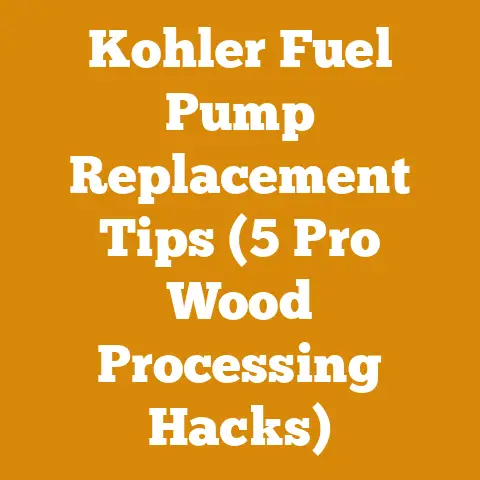Do I Need a Spin Down Filter for City Water? (Woodshop Water Use Tips)
Durability is everything, whether we’re talking about the tools we use or the wood we’re working with. But what about the water we use in our workshops? It might seem like an afterthought, but the quality of your water can significantly impact your equipment, your projects, and even your health. So, when I started noticing mineral buildup on my saw blades and sediment clogging my spray nozzles, I knew I had to take a closer look at my water source. This led me to the question: “Do I need a spin down filter for city water?”
In this article, I’ll share my experiences and research on using spin down filters in a woodshop setting, specifically when using city water. We’ll explore whether these filters are necessary, the benefits they offer, and how to choose the right one for your needs. I’ll also delve into real-world examples and data to help you make an informed decision. Let’s dive in!
Key Takeaways:
- Spin down filters remove sediment: They prevent dirt, rust, and other particles from entering your water system.
- City water isn’t always clean: Despite treatment, it can still contain sediment that can damage equipment.
- Benefits extend beyond woodshops: Protecting appliances, improving water quality, and reducing maintenance are all advantages.
- Choosing the right filter is crucial: Consider flow rate, micron rating, and connection size.
- Installation is straightforward: Most DIYers can handle the installation process with basic plumbing skills.
Why Worry About City Water in Your Woodshop?
Most of us assume that city water is clean and safe. After all, it goes through a treatment process before reaching our taps. However, that doesn’t mean it’s entirely free of contaminants, especially sediment. Even with municipal treatment, particles like rust, sand, and scale can still make their way into your water supply. These contaminants can wreak havoc in a woodshop environment.
The Hidden Dangers of Sediment
Sediment can cause a range of problems, including:
- Clogged nozzles and sprayers: This is especially problematic if you use water-based finishes or cooling systems for your power tools.
- Damaged equipment: Abrasive particles can wear down seals, valves, and other components in your machinery.
- Reduced water flow: Sediment buildup in pipes can restrict water flow, affecting the performance of your tools and processes.
- Poor finish quality: If you use water for misting or cleaning wood, sediment can leave unwanted particles on the surface, affecting the final finish.
My Own Close Call: A Story of a Clogged Sprayer
I learned the importance of water quality the hard way. I was working on a large walnut table, and I was using a water-based dye to enhance the grain. I’d spent hours sanding and preparing the surface, and I was finally ready to apply the finish. I started spraying the dye, and everything was going smoothly until, suddenly, the sprayer sputtered and stopped. I checked the nozzle, and it was completely clogged with tiny particles.
After disassembling and cleaning the sprayer, I discovered that the clog was caused by sediment from my water supply. It had never crossed my mind that my city water could be the culprit. This incident cost me several hours of work and nearly ruined the finish on my table. It was a wake-up call that I needed to take my water quality more seriously.
What is a Spin Down Filter?
A spin down filter is a type of pre-filter designed to remove sediment and other particulate matter from water. Unlike traditional cartridge filters, spin down filters use a centrifugal action to separate solids from the water.
How They Work
The filter housing is designed to create a swirling motion as water enters. This centrifugal force causes the heavier particles to be spun outward and downward, settling at the bottom of the filter housing in a collection chamber. The cleaner water then passes through a mesh screen before exiting the filter.
Advantages of Spin Down Filters
- Reusable: Unlike cartridge filters that need to be replaced regularly, spin down filters can be cleaned and reused.
- High flow rate: Spin down filters typically have a higher flow rate than cartridge filters, making them suitable for applications with high water demand.
- Easy to clean: Cleaning a spin down filter is a simple process that can be done in a few minutes.
- Visible sediment collection: The clear filter housing allows you to see the amount of sediment that has been collected, providing a visual indication of when it needs to be cleaned.
- Durable: Spin down filters are typically made from durable materials that can withstand high water pressure and temperature.
Different Types of Spin Down Filters
Spin down filters come in various sizes, materials, and micron ratings. Some models are designed for whole-house filtration, while others are more suitable for point-of-use applications. The micron rating refers to the size of the particles that the filter can remove. A lower micron rating means that the filter can remove smaller particles.
Do You Really Need a Spin Down Filter for City Water?
The short answer is: it depends. While city water is treated, it’s not always perfect. Several factors can influence the amount of sediment in your water supply, including:
- Age of the infrastructure: Older pipes can corrode and release rust and scale into the water.
- Water source: The quality of the source water (e.g., river, lake, well) can affect the amount of sediment present.
- Construction activity: Construction or repair work on water mains can stir up sediment and temporarily increase the amount of particulate matter in your water.
- Seasonal changes: Seasonal changes in water flow and temperature can affect the amount of sediment in your water supply.
Assessing Your Water Quality
Before deciding whether to install a spin down filter, it’s essential to assess your water quality. Here are a few ways to do that:
- Visual inspection: Fill a clear glass with water and let it sit for a few minutes. Look for any sediment that settles at the bottom of the glass.
- Check your fixtures and appliances: Look for signs of sediment buildup on faucets, showerheads, and appliances that use water.
- Test your water: You can purchase a water testing kit or hire a professional to test your water for sediment and other contaminants.
Data-Backed Insights: Sediment Levels in City Water
According to a study by the American Water Works Association (AWWA), the average turbidity (a measure of water clarity) in treated city water is around 0.1 to 0.5 NTU (Nephelometric Turbidity Units). However, turbidity levels can spike during periods of heavy rainfall or construction activity. A turbidity level above 1 NTU is considered noticeable to the human eye and may indicate the presence of sediment.
In a case study conducted in a city with aging water infrastructure, researchers found that sediment levels in the water supply increased by as much as 50% during periods of pipe repair. This highlights the importance of having a filtration system in place to protect your equipment and appliances from sediment damage.
Real-World Examples: When a Spin Down Filter is a Must
Here are a few scenarios where a spin down filter is highly recommended, even with city water:
- Using water-based finishes: Sediment can clog spray nozzles and affect the quality of the finish.
- Operating machinery with water cooling systems: Sediment can damage pumps, valves, and other components in the cooling system.
- Living in an area with aging water infrastructure: Older pipes are more likely to release rust and scale into the water.
- Experiencing frequent water main breaks or construction activity: These events can stir up sediment and temporarily increase the amount of particulate matter in your water.
- Having sensitive plumbing fixtures: High-end faucets, showerheads, and appliances can be more susceptible to damage from sediment.
Benefits of Using a Spin Down Filter in Your Woodshop
Even if your city water appears to be clean, installing a spin down filter can offer several benefits:
Protecting Your Equipment
As I mentioned earlier, sediment can damage your equipment and reduce its lifespan. A spin down filter can help protect your tools and machinery by removing abrasive particles from the water. This can save you money on repairs and replacements in the long run.
Improving Water Quality
A spin down filter can improve the overall quality of your water by removing sediment and other particulate matter. This can lead to cleaner, clearer water for washing, cleaning, and other tasks in your woodshop.
Reducing Maintenance
By preventing sediment buildup in pipes and fixtures, a spin down filter can reduce the amount of maintenance required to keep your water system running smoothly. This can save you time and effort on tasks like unclogging nozzles and cleaning pipes.
Extending the Life of Other Filters
If you use other types of water filters, such as carbon filters or reverse osmosis systems, a spin down filter can help extend their lifespan by removing sediment before it reaches them. This can save you money on filter replacements.
Peace of Mind
Knowing that your water is being filtered can give you peace of mind, especially if you rely on water for critical processes in your woodshop. You can focus on your work without worrying about sediment damaging your equipment or affecting the quality of your finishes.
Choosing the Right Spin Down Filter for Your Needs
Selecting the right spin down filter is crucial to ensure it effectively removes sediment and meets your specific requirements. Here are some factors to consider:
Flow Rate
The flow rate of a spin down filter is the amount of water it can process per minute or hour. Choose a filter with a flow rate that matches your water usage. If you have multiple tools or appliances that use water simultaneously, you’ll need a filter with a higher flow rate.
Micron Rating
The micron rating of a spin down filter determines the size of the particles it can remove. A lower micron rating means that the filter can remove smaller particles. For most woodshop applications, a filter with a micron rating of 50 to 100 microns is sufficient.
Connection Size
Make sure the connection size of the spin down filter matches the size of your water pipes. Most filters come with standard pipe thread sizes, such as 1/2 inch, 3/4 inch, or 1 inch.
Materials
Spin down filters are typically made from plastic or metal. Plastic filters are less expensive and suitable for most applications. Metal filters are more durable and can withstand higher water pressure and temperature.
Automatic vs. Manual Cleaning
Some spin down filters come with an automatic cleaning feature that periodically flushes out the sediment. This can save you time and effort on maintenance. However, automatic filters are typically more expensive than manual filters.
Brand and Reputation
Choose a spin down filter from a reputable brand with a proven track record of quality and performance. Read reviews and compare prices to find the best option for your needs.
My Recommendation: A Look at Specific Models
Based on my research and experience, here are a few spin down filters that I would recommend for woodshop applications:
- Rusco RUS-50-FOB Spin Down Filter: This is a popular and reliable filter that offers excellent sediment removal. It has a clear housing for easy monitoring and is available in various sizes and micron ratings.
- iSpring WSP-50 Reusable Spin Down Sediment Filter: This filter is a good value for the price and offers a high flow rate. It’s easy to install and clean.
- Aqua-Pure AP110 Whole House Sediment Filter: This filter is designed for whole-house filtration but can also be used for point-of-use applications in a woodshop. It has a durable construction and a long lifespan.
Installing Your Spin Down Filter: A Step-by-Step Guide
Installing a spin down filter is a relatively straightforward process that most DIYers can handle. Here’s a step-by-step guide:
Gather Your Materials
- Spin down filter
- Pipe fittings (if needed)
- Pipe wrench
- Teflon tape
- Bucket
- Screwdriver
Turn Off the Water Supply
Locate the main water shut-off valve and turn it off. This will prevent water from flowing while you’re installing the filter.
Choose a Location
Select a suitable location for the filter. It should be easily accessible for cleaning and maintenance. Consider installing the filter near the main water supply line or at the point where you need filtered water.
Cut the Pipe (If Necessary)
If you’re installing the filter on an existing water line, you’ll need to cut the pipe to create space for the filter. Use a pipe cutter to make a clean cut.
Install the Filter
Wrap Teflon tape around the threads of the pipe fittings. Connect the fittings to the filter and tighten them with a pipe wrench. Make sure the filter is installed in the correct direction, as indicated by the arrows on the filter housing.
Turn On the Water Supply
Slowly turn on the main water shut-off valve. Check for leaks around the filter connections. Tighten the fittings if necessary.
Flush the Filter
Open a nearby faucet and let the water run for a few minutes to flush out any air or debris from the filter.
Monitor the Filter
Check the filter regularly to see how much sediment has been collected. Clean the filter when it becomes full or when you notice a decrease in water flow.
Expert Insight: Plumbing Tips for Filter Installation
I spoke with a local plumber, Mark Johnson, about the best practices for installing spin down filters. Here’s what he had to say:
“When installing a spin down filter, it’s crucial to use Teflon tape on all threaded connections to prevent leaks. Also, make sure to support the filter properly to prevent stress on the pipes. If you’re not comfortable working with plumbing, it’s always best to hire a professional.”
Maintaining Your Spin Down Filter
Regular maintenance is essential to keep your spin down filter working effectively. Here are some tips:
Cleaning the Filter
Clean the filter regularly, depending on the amount of sediment in your water. Most filters can be cleaned by opening a valve at the bottom of the filter housing to flush out the sediment. Some filters may require you to remove the filter screen and clean it manually.
Replacing the Filter Screen
The filter screen may need to be replaced periodically if it becomes damaged or clogged. Check the manufacturer’s recommendations for replacement intervals.
Inspecting the Filter Housing
Inspect the filter housing regularly for cracks or leaks. Replace the housing if necessary.
Documenting Maintenance
Keep a record of when you clean and maintain your filter. This will help you track its performance and identify any potential problems.
Troubleshooting Common Issues
- Low water flow: This could be caused by a clogged filter screen or sediment buildup in the pipes. Clean the filter and flush the pipes to resolve the issue.
- Leaks: Check the filter connections for leaks. Tighten the fittings or replace the Teflon tape if necessary.
- Cloudy water: This could be caused by excessive sediment in the water. Clean the filter more frequently or consider installing a filter with a lower micron rating.
The Environmental Impact of Water Filtration
While the primary goal of a spin down filter is to protect your equipment and improve water quality, it’s also important to consider the environmental impact of water filtration.
Reducing Water Waste
By preventing sediment buildup in pipes and fixtures, a spin down filter can help reduce water waste. Clogged pipes can restrict water flow, leading to increased water pressure and higher water consumption.
Extending the Lifespan of Appliances
By protecting appliances from sediment damage, a spin down filter can extend their lifespan, reducing the need for replacements. This can save resources and reduce waste.
Minimizing Chemical Use
In some cases, sediment can react with chemicals in the water, creating unwanted byproducts. By removing sediment, a spin down filter can minimize the need for chemical treatments.
Sustainable Practices
When choosing a spin down filter, look for models that are made from recycled materials or that are designed for easy disassembly and recycling.
Beyond the Woodshop: Other Applications for Spin Down Filters
While I’ve focused on using spin down filters in a woodshop setting, these filters have many other applications, including:
- Residential use: Protecting appliances, improving water quality, and reducing maintenance.
- Agricultural use: Filtering irrigation water to prevent clogged nozzles and improve crop yields.
- Industrial use: Filtering process water to protect equipment and ensure product quality.
- Commercial use: Filtering water for restaurants, hotels, and other businesses.
Final Thoughts: Is a Spin Down Filter Right for You?
So, do you need a spin down filter for city water in your woodshop? Based on my experience and research, I believe that it’s a worthwhile investment for most woodworkers, especially those who rely on water for critical processes.
While city water is treated, it’s not always free of sediment. A spin down filter can provide an extra layer of protection for your equipment, improve the quality of your water, and reduce maintenance.
Ultimately, the decision of whether to install a spin down filter depends on your individual needs and circumstances. Assess your water quality, consider the potential benefits, and weigh the costs before making a decision.
Actionable Next Steps
- Assess your water quality: Perform a visual inspection or test your water for sediment.
- Evaluate your needs: Consider how you use water in your woodshop and whether sediment could be causing problems.
- Research spin down filters: Compare different models and choose one that meets your needs.
- Install the filter: Follow the step-by-step guide or hire a professional plumber.
- Maintain the filter: Clean and inspect the filter regularly to ensure it’s working effectively.
By taking these steps, you can protect your equipment, improve your water quality, and enjoy a more efficient and productive woodshop.






